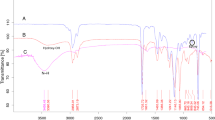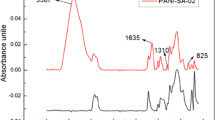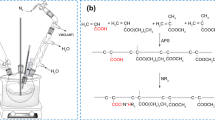Abstract
An antistatic and electrically conductive acrylic–polyaniline nanocomposite coating was successfully synthesized by interfacial polymerization of aniline in the presence of acrylic latex. The acrylic latex was prepared through emulsion polymerization, and aniline was polymerized by in situ interfacial polymerization at the interface of acrylic latex/chloroform phase. Fourier transform infrared spectroscopy (FTIR), UV–Vis spectroscopy and CHNS elemental analysis revealed the existence of 6.24 wt% emeraldine salt of polyaniline (PAni) in the dried film of the nanocomposite. Scanning electron microscopy (SEM) confirmed the presence of colloidal polymer particles in the aqueous phase which was confirmed to have some advantages, including prevention of aggregation of particles, dispersibility improvement and enhancement of the PAni nanofibers aspect ratio in the acrylic polymer matrix. According to SEM results, PAni fibers with the length ranging from 12 to 67 µm and diameters between 0.078 and 1 µm, highly dispersed in the acrylic polymer matrix, were successfully synthesized. Thermal, electrical and mechanical properties of the acrylic copolymer were significantly affected by PAni incorporation. The onset degradation temperature in thermogravimetric analysis revealed that the thermal stability of the nanocomposite was improved compared to that of the pure acrylic copolymer. The nanocomposite film showed electrical conductivity of about 0.025 S/cm at room temperature, along with satisfactory mechanical properties, attractive as an antistatic material in coating applications.







Similar content being viewed by others
References
Coyard H, Oldring PK, Deligny P, Tuck N (2001) Resins for surface coatings: acrylics and epoxies. Wiley, New York
Sangermano M, Foix D, Kortaberria G, Messori M (2013) Multifunctional antistatic and scratch resistant UV-cured acrylic coatings. Prog Org Coat 76:1191–1196
Roessler A, Schottenberger H (2014) Antistatic coatings for wood-floorings by imidazolium salt-based ionic liquids. Prog Org Coat 77:579–582
Baughman RH, Zakhidov AA, de Heer WA (2002) Carbon nanotubes: the route toward applications. Science 297:787–792
Soto-Oviedo MA, Araújo OA, Faez R, Rezende MC, De Paoli MA (2006) Antistatic coating and electromagnetic shielding properties of a hybrid material based on polyaniline/organoclay nanocomposite and EPDM rubber. Synth Met 156:1249–1255
Guntermann U, Elschner A, Kirchmeyer S (2015) Conductive polymer layer as an antistatic protection shield for polarization filter. US Patent 20150064449 A1
Ansari SP, Mohammad F (2016) Conducting nanocomposites of polyaniline/nylon 6,6/zinc oxide nanoparticles: preparation, characterization and electrical conductivity studies. Iran Polym J 25:363–371
Ćirić-Marjanović G (2013) Recent advances in polyaniline research: polymerization mechanisms, structural aspects, properties and applications. Synth Met 177:1–47
Mostafaei A, Nasirpouri F (2014) Epoxy/polyaniline–ZnO nanorods hybrid nanocomposite coatings: synthesis, characterization and corrosion protection performance of conducting paints. Prog Org Coat 77:146–159
Navarchian AH, Joulazadeh F, Karimi F (2014) Investigation of corrosion protection performance of epoxy coatings modified by polyaniline/clay nanocomposites on steel surfaces. Prog Org Coat 77:347–353
Dhawan SK, Singh N, Rodrigues D (2003) Electromagnetic shielding behaviour of conducting polyaniline composites. Sci Technol Adv Mater 4:105–113
Sapurina I, Stejskal J, Špírková M, Kotek J, Prokeš J (2005) Polyurethane latex modified with polyaniline. Synth Met 151:93–99
Lee SM, Lee SJ, Kim JH, Cheong IW (2011) Synthesis of polystyrene/polythiophene core/shell nanoparticles by dual initiation. Polymer 52:4227–4234
Borthakur LJ, Konwer S, Das R, Dolui SK (2011) Preparation of conducting composite particles of styrene–methyl acrylate copolymer as the core and graphite-incorporated polypyrrole as the shell by surfactant-free miniemulsion polymerization. J Polym Res 18:1207–1215
Yang F, Zhu A (2015) Preparation and characterization of polyaniline-poly (styrene-acrylate) composite latexes. Polym Bull 72:2503–2518
Huijs F, Vercauteren F, Hadziioannou G (2001) Resistance of transparent latex films based on acrylic latexes encapsulated with a polypyrrole shell. Synth Met 125:395–400
Li R, Chen Z, Li J, Zhang C, Guo Q (2013) Effective synthesis to control the growth of polyaniline nanofibers by interfacial polymerization. Synth Met 171:39–44
Huang J, Kaner RB (2004) A general chemical route to polyaniline nanofibers. J Am Chem Soc 126:851–855
Olad A, Barati M, Shirmohammadi H (2011) Conductivity and anticorrosion performance of polyaniline/zinc composites: investigation of zinc particle size and distribution effect. Prog Org Coat 72:599–604
Gharieh A, Mahdavian AR, Salehi-Mobarakeh H (2014) Preparation of core–shell impact modifier particles for PVC with nanometric shell thickness through seeded emulsion polymerization. Iran Polym J 23:27–35
Tripathi AK, Sundberg DC (2013) Partitioning of functional monomers in emulsion polymerization: distribution of carboxylic acid monomers between water and multimonomer systems. Ind Eng Chem Res 52:9763–9769
Huang J, Virji S, Weiller BH, Kaner RB (2003) Polyaniline nanofibers: facile synthesis and chemical sensors. J Am Chem Soc 125:314–315
Chen CH, Kan YT, Mao CF, Liao WT, Hsieh CD (2013) Fabrication and characterization of water-based polyurethane/polyaniline conducting blend films. Surf Coat Technol 231:71–76
Trchová M, Šeděnková I, Tobolková E, Stejskal J (2004) FTIR spectroscopic and conductivity study of the thermal degradation of polyaniline films. Polym Degrad Stab 86:179–185
Chen SA, Fang WG (1991) Electrically conductive polyaniline-poly (vinyl alcohol) composite films: physical properties and morphological structures. Macromolecules 24:1242–1248
Jin Y, Huang S, Zhang M, Jia M (2013) Preparation of sulfonated graphene–polyaniline nanofiber composites by oil/water interfacial polymerization and their application for supercapacitors. Synth Met 168:58–64
Chen CH, Dai YF (2011) Effect of chitosan on interfacial polymerization of aniline. Carbohydr Polym 84:840–843
Dai T, Qing X, Wang J, Shen C, Lu Y (2010) Interfacial polymerization to high-quality polyacrylamide/polyaniline composite hydrogels. Compos Sci Technol 70:498–503
Guan H, Fan LZ, Zhang H, Qu X (2010) Polyaniline nanofibers obtained by interfacial polymerization for high-rate supercapacitors. Electrochim Acta 56:964–968
Dallas P, Georgakilas V (2015) Interfacial polymerization of conductive polymers: generation of polymeric nanostructures in a 2-D space. Adv Colloid Interface Sci 224:46–61
Yu H, Chen P, Chen W, Liu Y (2014) Effect of cellulose nanofibers on induced polymerization of aniline and formation of nanostructured conducting composite. Cellulose 21:1757–1767
Plesu N, Ilia G, Pascariu A, Vlase G (2006) Preparation, degradation of polyaniline doped with organic phosphorus acids and corrosion essays of polyaniline–acrylic blends. Synth Met 156:230–238
Rahim-Abadi MM, Mahdavian AR, Gharieh A, Salehi-Mobarakeh H (2015) Chemical modification of TiO2 nanoparticles as an effective way for encapsulation in polyacrylic shell via emulsion polymerization. Prog Org Coat 88:310–315
Acknowledgements
The authors are grateful to the University of Tabriz for support of the project.
Author information
Authors and Affiliations
Corresponding author
Rights and permissions
About this article
Cite this article
Mirmohseni, A., Gharieh, A. & Khorasani, M. Waterborne acrylic–polyaniline nanocomposite as antistatic coating: preparation and characterization. Iran Polym J 25, 991–998 (2016). https://doi.org/10.1007/s13726-016-0486-9
Received:
Accepted:
Published:
Issue Date:
DOI: https://doi.org/10.1007/s13726-016-0486-9




